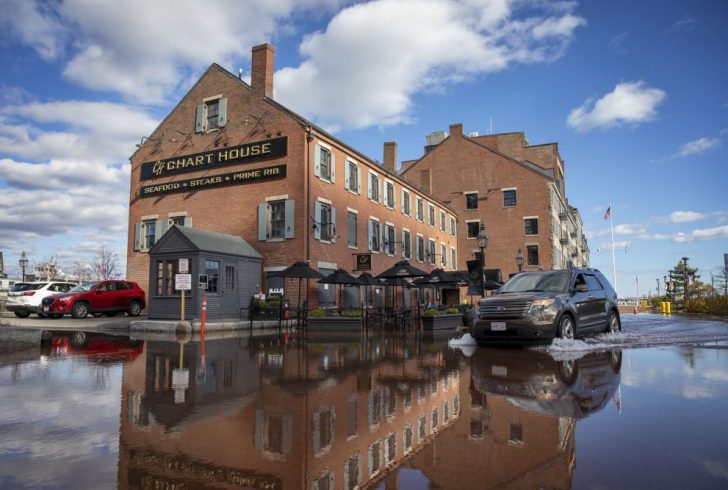Adapting to water rather than fighting it


Check out the new op-ed in CommonWealth Magazine written by Stone Living Lab Managing Director Joe Christo and Boston Harbor Now CEO & President Kathy Abbott about Boston prioritizing nature-based approaches to climate change.
Ten years ago, Superstorm Sandy – after ravaging the Caribbean and much of the East Coast of the United States – turned inward and exerted its full force on New York City and the surrounding region, leading to tens of billions of dollars in damages, crippling the city’s subway system, and causing widespread power outages.
Officials have attributed over 100 deaths to the storm, with 44 people dying in New York City alone, and countless others were directly and indirectly affected by the storm. The storm’s path did not affect Boston in the same way that it affected New York City, and in the 10 years since, extensive cooperation among city, state, and federal agencies, scientists, and community leaders has helped the Boston region become a national leader in planning for our climate future, but we still have an urgent need to act on many fronts.
In Boston, the Environment Department’s 2016 Climate Ready Boston report, drafted with the Green Ribbon Commission, established a new framework for climate resilience planning and has been followed by neighborhood-level Coastal Resilience Solutions plans that focus on identifying adaptation approaches for Boston’s most vulnerable flood pathways, including a recent plan for East Boston and Charlestown.
Resilient Boston Harbor has helped residents envision what a truly accessible and resilient waterfront can look like, while a whole separate and equally impressive track of work is focused on mitigation and carbon neutrality. The Boston Planning and Development Agency has also established a Coastal Flood Resilience Zoning Overlay District and released complementary design guidelines that help ensure that new construction projects and retrofits are preparing for the effects of climate change. There has been a strong focus on prioritizing implementation of adaptation projects identified in these reports, and projects like Langone Park and Puopolo Playground, Martin’s Park, Moakley Park, and Clippership Wharf are helping to protect their respective neighborhoods from sea-level rise and flooding while becoming models of how we can live, work, and play alongside a changing waterfront.
Central to all of these efforts is an approach to resilience that adapts to water instead of fighting it. Boston, like many coastal communities around the world, is prioritizing nature-based approaches such as natural berms and floodable green spaces as opposed to mammoth infrastructure like concrete seawalls. UMass Boston’s 2018 Harbor Barrier report recommended that nature-based approaches can provide effective protection, restore ecosystems, and create vibrant and welcoming shorelines for residents of all of the communities around Boston Harbor.
In the years since Sandy, the climate – both atmospheric and political – has become even more unpredictable and volatile. Fulfilling the Boston region’s approach to adaptation, and ensuring we’re ready for the next superstorm, means accelerating progress on three simultaneous challenges.
First, the city continues to acknowledge and plan for the fact that the consequences of climate change will weigh heavily on our most vulnerable communities. Just as the COVID-19 pandemic has laid bare the vast socioeconomic inequalities across Boston and the nation, so too will the rising seas and intensifying storms that are sure to increase in the years and decades to come. The region must continue to lead in this arena, by ensuring that social justice is prioritized at every step of our resilience planning.
Second, we must continue to innovate around nature-based approaches that we can implement not just parcel by parcel, but at a district scale or larger. By creating prototypes and expanding our toolbox of options, we can create new approaches such as ecologically and people-friendly mini-barriers created with natural materials, rocky intertidal boulder fields designed to absorb wave energy, and even a tiered system with multiple layers of natural protection that increase biodiversity while enhancing the resiliency of our shoreline.
And finally, we must identify ways to pay for all of this. Federal, state, local, and private infrastructure funding must all be managed at a scale that meets this challenge and supports nature-based approaches.
Climate change is a challenge that requires everyone at the table – public partners at all levels of government, the private sector, scientists, and, most importantly, the residents in communities most at risk.
One exciting new collaboration, the Stone Living Lab, will help us address these challenges by creating an innovative and collaborative ecosystem that engages scientists and the community in research, education, and the promotion of equity. The lab is a partnership between Boston Harbor Now, UMass Boston School for the Environment, the National Parks of Boston, the Massachusetts Department of Conservation and Recreation, the Massachusetts Executive Office of Energy and Environmental Affairs, the city of Boston, and the James M. and Cathleen D. Stone Foundation. It aims to become a global hub for testing and scaling up nature-based approaches in the high-energy environment of the Boston Harbor Islands National and State Park.
Boston is known throughout the world as a leader in life sciences, technology, medicine, and education. Today we have the opportunity – and the imperative – to become a global leader in developing innovative, science, and community-based protections for vulnerable waterfronts, people, and coastal ecosystems.
Superstorm Sandy was an event of a lifetime, and Hurricane Ian most recently reminded us that we can no longer assume decades will pass before we see another storm like it. By working together, and committing ourselves to our shared responsibility, we can create a more resilient, equitable, and accessible shoreline across the city and the Commonwealth, and serve as an inspiration to and model for coastal communities around the world.